When an employer decides to legally and compliantly employ an internationally remote employee, one of the first things they need to come to terms with are the employee rights of their country. Here is a guide to employee rights in Ireland.
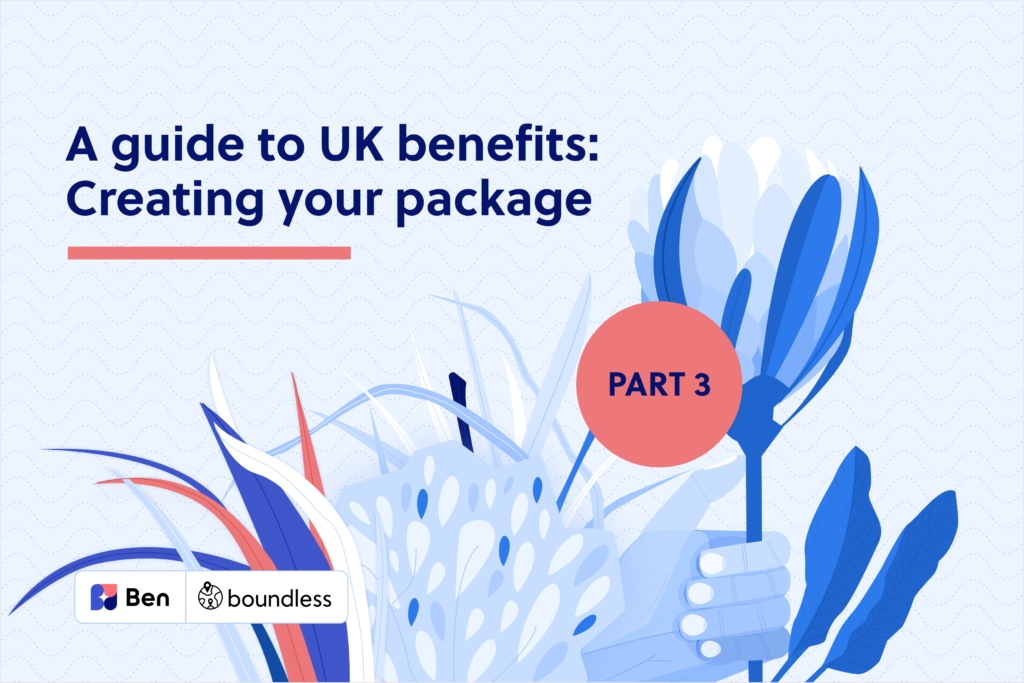
Building a UK employee benefits package from scratch can feel quite daunting. As we outlined in the first and second parts of this collaboration series between Boundless and Ben, when there are so many options as well as tax implications to consider, creating the perfect set up can feel like a real mountain to climb.
After statutory benefits have been sorted, the fun part of deciding which additional benefits and perks to add begins. You will have to determine which benefits in kind and perks will have the highest return on investment whilst enhancing the employee experience and company culture. Given the times we are living in, emphasising your employees' health and wellbeing is a great starting point. But what else, beyond that, should you prioritise?
In this third and final part to our UK benefits guide, we offer you a framework to help you to decide. Weaved into it are real-world examples from four companies whom we interviewed and who are at different stages of the process. Keeping an eye on what other companies who are like you are doing will not only inspire you but give you a realistic outlook on how to remain competitive in the market. Let's dive in.
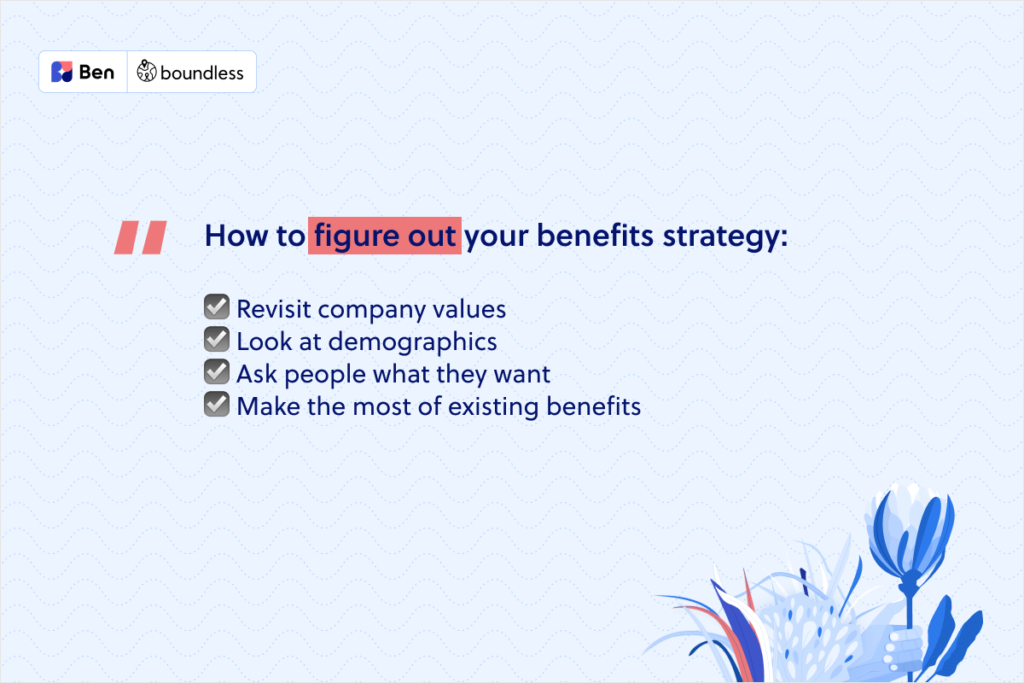
The companies we spoke with were chosen intentionally to be at different stages in terms of team size, fundraising, and company maturity. As a result they are all at various points of their benefits strategy journey. Dataswift is an early-stage startup, Beamery is a B2B scaleup, Trouva is an ecommerce scale-up, and Formidable is an established consultancy.
Regardless of where you are on your journey, a great place to start is by revisiting your company values. Thinking about what culture you want to create begins with the ethos of your business.
One of our interviewees, Sinead Daly, Employee Experience Lead at Beamery, offered a great example of tying together values and benefits. One of the company's values is "start with why," which is all about curiosity, digging deep, and putting customers first. To feed the curiosity, the company recently started giving a Kindle to every employee.
However, the scale-up does not stop at simply handing people Kindles, they also work to activate their usage. The company has launched its first of many book clubs, which stimulates the use of the Kindles and creates a community of curious readers. "This turns the Kindle from being a perk to being an enriching experience for everyone," Sinead says. Unsurprisingly, the Kindles are already one of the favourite perks on offer.
The next step in figuring out your benefit offering is to take into consideration the roadmap of the business. Part of the planning process is gauging what milestones are likely to occur over the next 12 months from investment to recruitment, locally and remotely, and expansion into other markets.
If you are a scaling business in particular, think about how much time and resources that the implementation and ongoing management of your benefits strategy are likely to consume. As an Employee Experience Lead, a large part of Sinead's time is taken up by sorting benefits.
Offering a new employee benefit, especially one that the business has to pay for, can be risky. A selection that doesn't resonate with employees will result in a loss of time and resources. It also remains that once you offer a benefit, you want to avoid having to take it away later down the line because some employees will feel bereft of it then! Tying your strategy back to your business fundamentals will help.
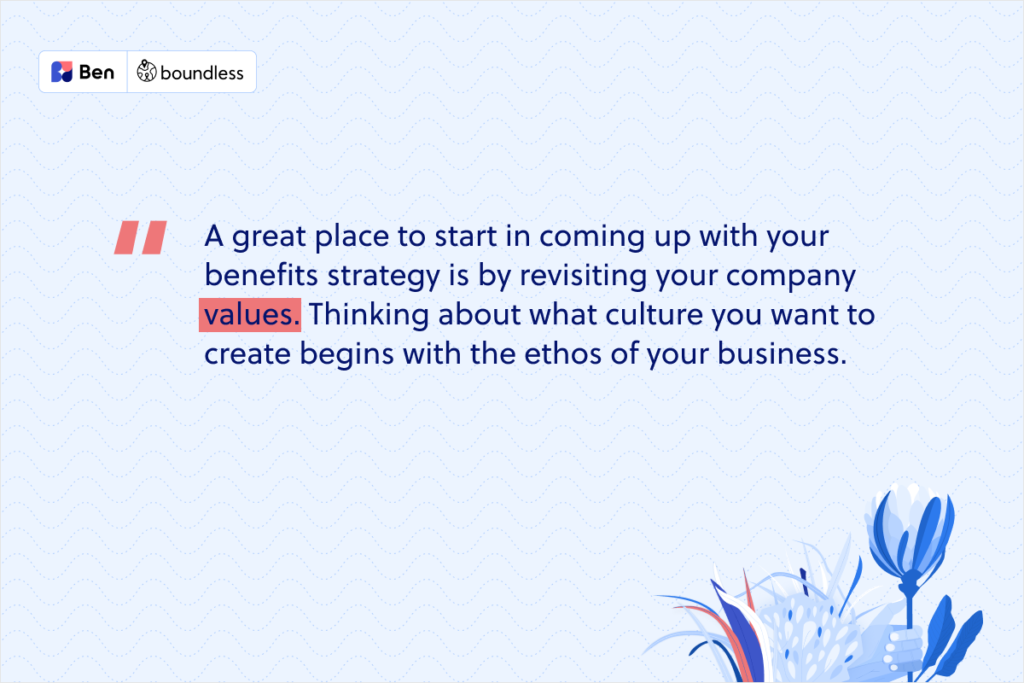
Deciding which avenue or multiple avenues of benefits to pursue ultimately depends on several factors, including the size and budget of your company (we offer a sample budget later in this article), as well as the location of your company.
A helpful guide for determining the pool of options include these categories which Ben use for customers:
Beamery takes this a step further, by thinking of its benefits not simply as what they are but as what they enable people to do. According to Sinead, this represents a more holistic approach as it looks at benefits in terms of what needs and essential parts of the employee's life they contribute to, rather than just a list. Their five distinct pillars are:
Another great way in finding out what choice to make is to ask people what they want. Many companies can assist with in-depth feedback surveys but a simple form, distributed regularly, will help you keep tabs on the evolving needs of your people. Sometimes, however, simply asking people what they need can be a great starting point.
That is precisely what Brooke Paske, Director of Operations at Formidable did at the onset of the pandemic as the lockdown was imposed in the countries where the company has offices. While the consultancy already had a great benefits and perks package, she knew she had to make sure things were relevant for the current environment. "Be honest and tell us about anything that could make your life better. We may not be able to say yes to everything, but if we can make your lives a little better during this tough time, we want to try," she said to everyone.
To everyone’s all round pleasant surprise, Formidable’s existing offering was already helpful in a lot of ways when the going got tough. For some employees, this came in the form of things like private medical insurance and dental cover, while for others, having flexibility with their time to do things like homeschool their children was a real bonus.
When asked that very same question further along the line in lockdown, social connection came up as the highest on the list. More regular virtual get-togethers, happy hours, yoga sessions and similar online happenings are some of the benefits that have been put in place to help to continue the strong people-first culture built before lockdown.
As with many things these days, when making any business decisions, it's important to look at the data, in particular at company demographics. Looking at employees’ age, roles, salary, location etc. will give you a great picture of the needs of your people.
That is exactly what Chloe Bartle, People and Culture Partner at Trouva did when the time came to go beyond statutory benefits. Many of Trouva's employees are women in their late twenties and early thirties. That's why it made sense to review the existing parental leave and increase it. With the demographic in mind, they did a complete overhaul of both the maternity and paternity policies allowing for more paid time off.
Knowing your people and their habits and needs can help educate the choices you make about perks. If for example, the majority of your team are millennials, working in high pressure, commission-based, sales roles in London, mental health support and gym subsidies will make far more sense over income protection or a car allowance.
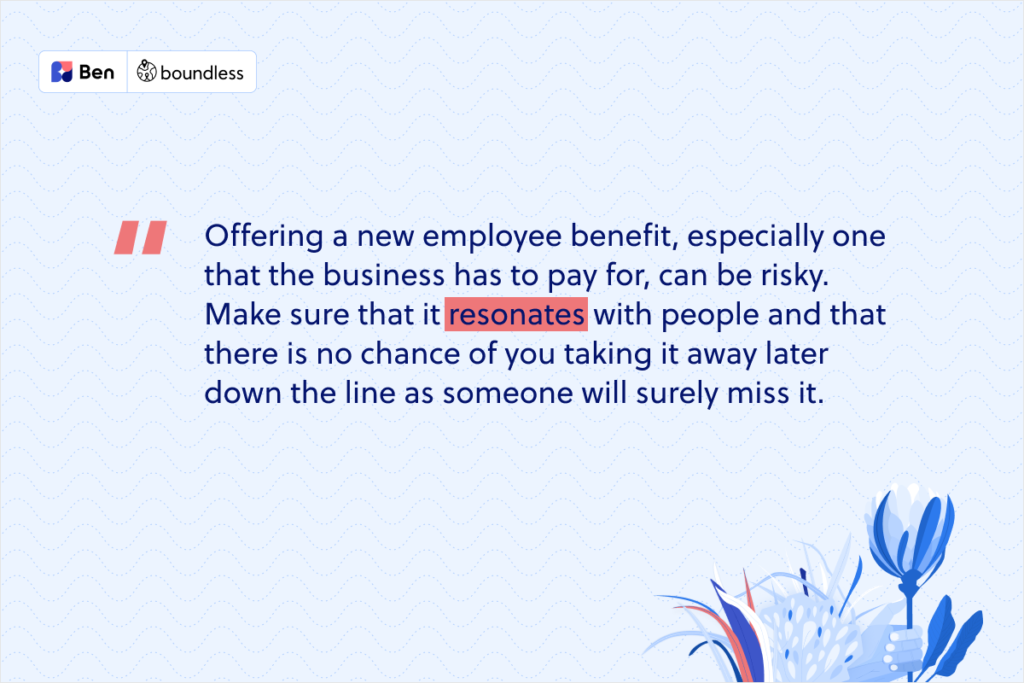
Even when budgets are restricted, a little creative thinking can go a long way, especially in the current climate.
A post-seed funding startup, Dataswift, was used to operating under constraints even before Covid-19 took flight. As a distributed startup, the "onsites" that allowed remote-working team members to connect every two months had been a favoured benefit. Likewise, so had been the perks of coming together in the London office for those who worked there. As travel became restricted and the office in London was forced to close, both benefits lost their allure for the foreseeable future. Phoebe Yiin, its Head of Operations, wondered what they could be replaced with.
Initially, Phoebe turned to supporting the mental health of employees. She knew Covid-19 was causing anxiety and stress for many, so she introduced Spill, a tool that promotes mental health and added two mental health days a month.
The constraints of an early-stage startup required her to carefully determine what would be of most value and have the best uptake. She started with time off, as this benefit did not come with added financial pressure. Paid time off was increased to 38 days regardless of employee location. On top of that, Dataswift introduced two paid and three unpaid volunteering days and a sabbatical week every two years.
The difficulty of transitioning perks from the office to the home is something that each of the four companies experienced. They have each had to think outside the box and look at new ways to perk up people, which doesn't involve great coffee, healthy office snacks or drinks on a Friday.
As you will see below when we list all of their packages, the companies and their People Ops experts have turned to a variety of solutions that would fit a variety of budgets: virtual social activities, access to meditation and mental health support tools, financial wellbeing, more paid time off.
To get additional inspiration, keep an eye on the different technologies available on the market. Wellness technology is one of the fastest-growing spaces, particularly in the area of mental health. Great examples include Babylon Health for online GP consultations, FiiT for online exercise classes and Nudge for financial education.
That said, it's also important to remember that at times the best return on investment is focusing on making the most of existing perks over adding more. This is something that Chloe has been doing at Trouva. Partly because historically people haven't always availed of the existing benefits, and partly due to a decision to wait out to see how the next months of the pandemic go before committing to any significant benefits overhaul, this has been the most sensible thing to do.
"We have realised just how important the micro-moments happening in the office are and would like to return to them as soon as it becomes safe to do so," Chloe says. While Trouva has added budgets for virtual team socials for employees, Chloe is focused on looking at what there is already in place through providers such as Perkbox and Ben and reminding people about it.
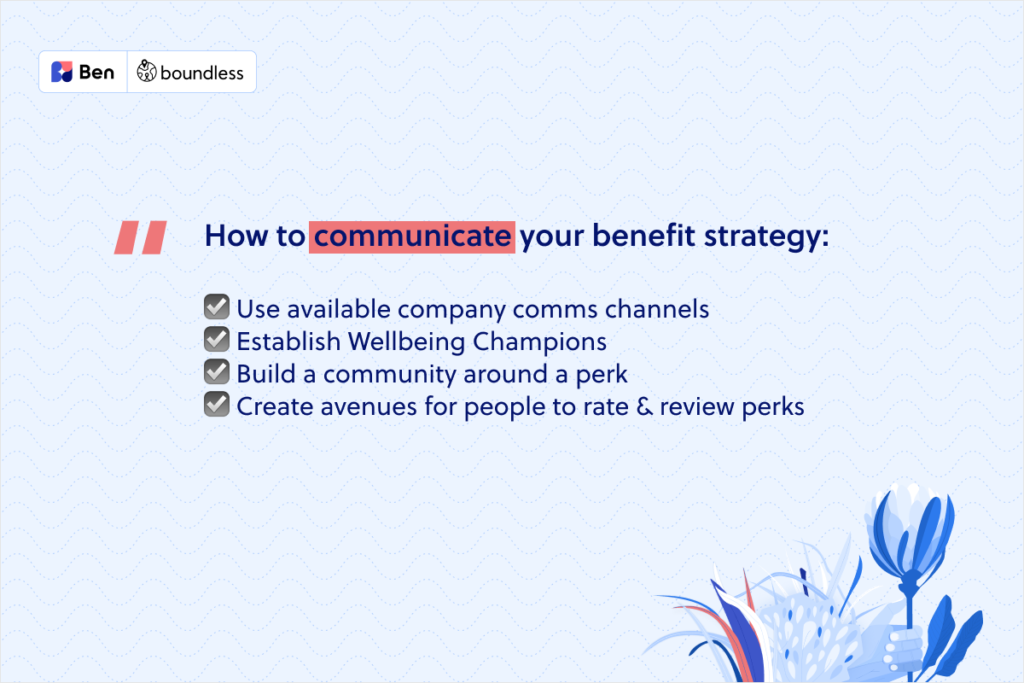
Building a successful benefits strategy is an ongoing process of review, renew and refresh. Once you have rolled out a selection of benefits, make sure to keep a tab on the engagement levels - the results might surprise you! It will give you a great indication of where to allocate more resources in the future.
As Trouva's example shows, the communication of benefits is a considerable part of an effective benefits strategy. All too often, employees are unaware, forget or just don't understand what it is that's on offer to them.
According to Sinead from Beamery, you have to take the time to educate people on why perks and benefits exist in the first place and reassure them it is okay to use them. This has to happen continuously, not just at the time of onboarding, which is the sort of employee experience future that Beamery is working towards. Employees are just as prone to choice paralysis when it comes to benefits, as the PeopeOps partners deciding what those benefits should be in the first place.
From email and Slack, through the company drive, all the way to one-to-ones with the line manager, use all channels available to communicate the offering. A little nudge here and there can go a long way.
People also love hearing about the experiences and recommendations of their peers. Beamery makes the most of that when it comes to their home office stipends. The company has a designated Slack channel, where people can share what home office setups they have, post pictures of the gear they bought, and rate and review it. In a way, the public channel gives permission to people to make the most of the subsidy but also creates a connection between them.
Another effective way to stimulate the use of benefits and connect people through them is to have a Wellbeing Champion in the organisation - someone dedicated to supporting teams using the benefits available. This person doesn't necessarily have to be in HR but could be one (or a few selected people) across the company that takes company wellbeing under their wing.
As you start developing a more comprehensive benefits package, you could also look at streamlining delivery through brokers and benefits experts who have the expertise to obtain preferential rates and have the expertise to tell you what's hot in the world of employee benefits.
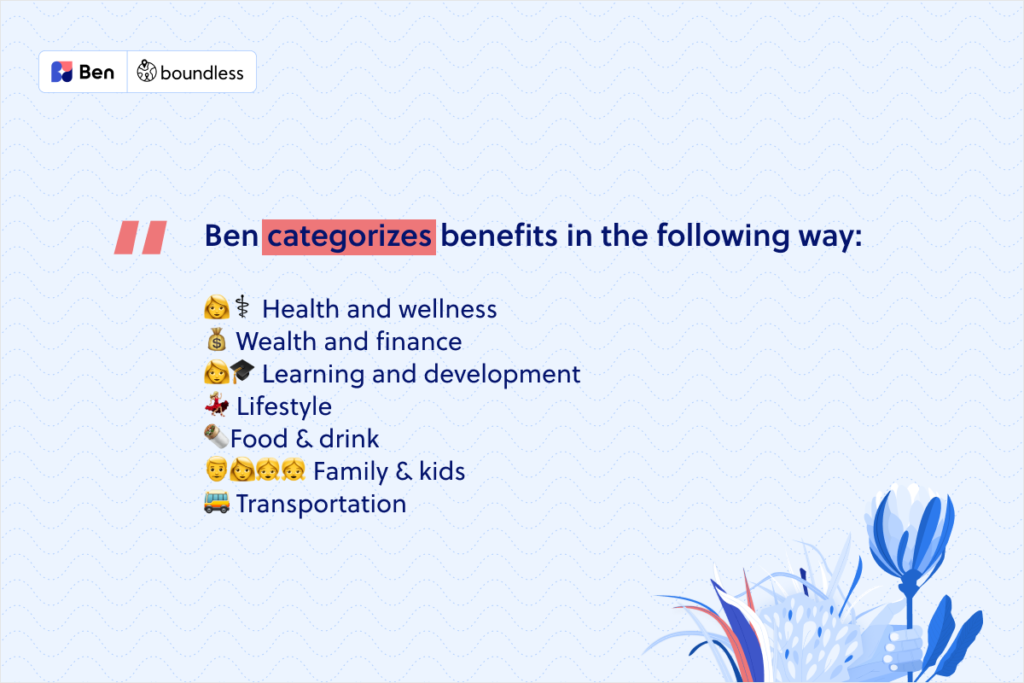
The creation of a successful benefits program never really reaches an endpoint; instead, it's an ever-evolving space with new challenges and opportunities that grow alongside the development of the business and the world around us.
For reference, these are the current benefit packages of the four organisations we spoke to (we have omitted some of the things that are not currently relevant due to the pandemic):
Dataswift
Share options, expanded annual leave, remote working (for office staff), company socials, volunteering days, Spill, mental health days, sabbaticals.
Beamery
Expanded maternity leave, wellbeing days, volunteering days, pension, medical benefits, share options, allowances and subsidies (for L&D, health and wellbeing, home office setup), cycle to work, Kindles, gifts on employee birthdays
Trouva
Expanded maternity/paternity leave, expanded fully paid sick leave, share options, employee discounts, cycle to work, office snacks, expanded annual leave and remote working for office-based staff.
Formidable
Expanded maternity/paternity coverage, pension, financial wellbeing, medical benefits, protection & group risk, allowances and subsidies (L&D, health, food, remote working), childcare, cycle to work, season ticket loan, rewards for work on Open Source Software projectscharitable giving, company socials.
Given the changing world we are living in, all four of the companies are in a state of transition and their packages will surely evolve. As they work to meet the most urgent needs of their employees and harmonise experiences across borders, they all speak of bringing in more flexibility. Instead of offering a list of benefits, they dabble with consolidating budgets, switching offers to a pot of money or a token system, all in the aim of leaving people to decide for themselves what matters most. While the future may be uncertain, putting thought and consideration into creating and evolving the benefits offering is the best approach to determining the right way forward.
To come up with the final package, you will also have to take into consideration the costs to the company and the tax implication on the take-home pay for employees.
We have created an estimated benefits package budget per employee. We have based this on a combination of what employees currently want most as well as what companies are most keen to offer.
We then add three separate calculations:
For the calculation, we are assuming the benefactor is a single employee, 35 years of age, with no dependents and not living in Scotland.
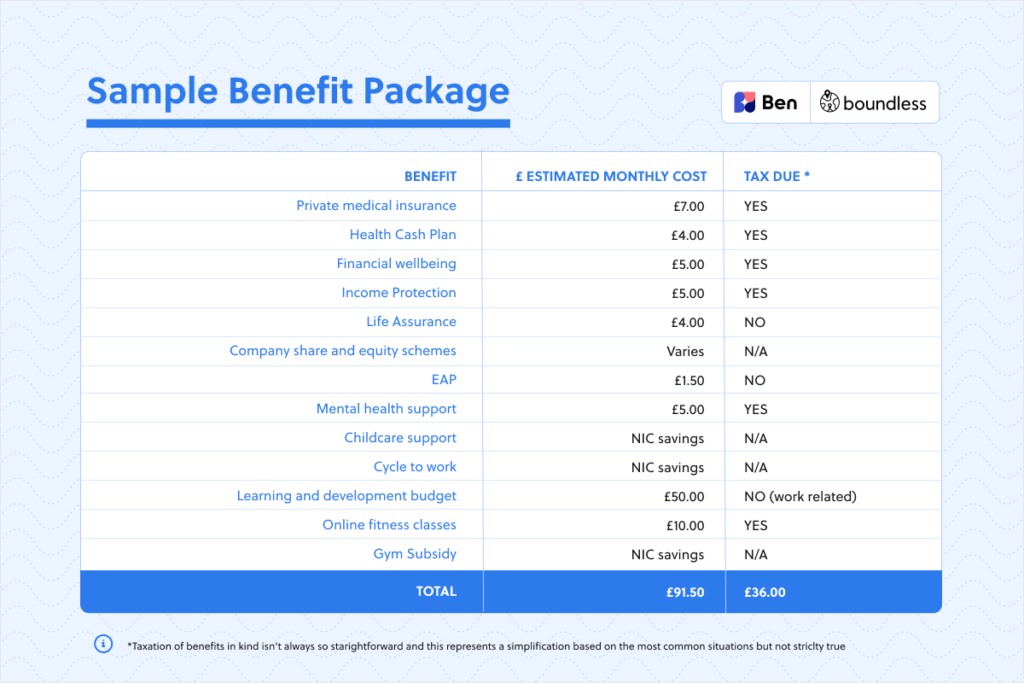
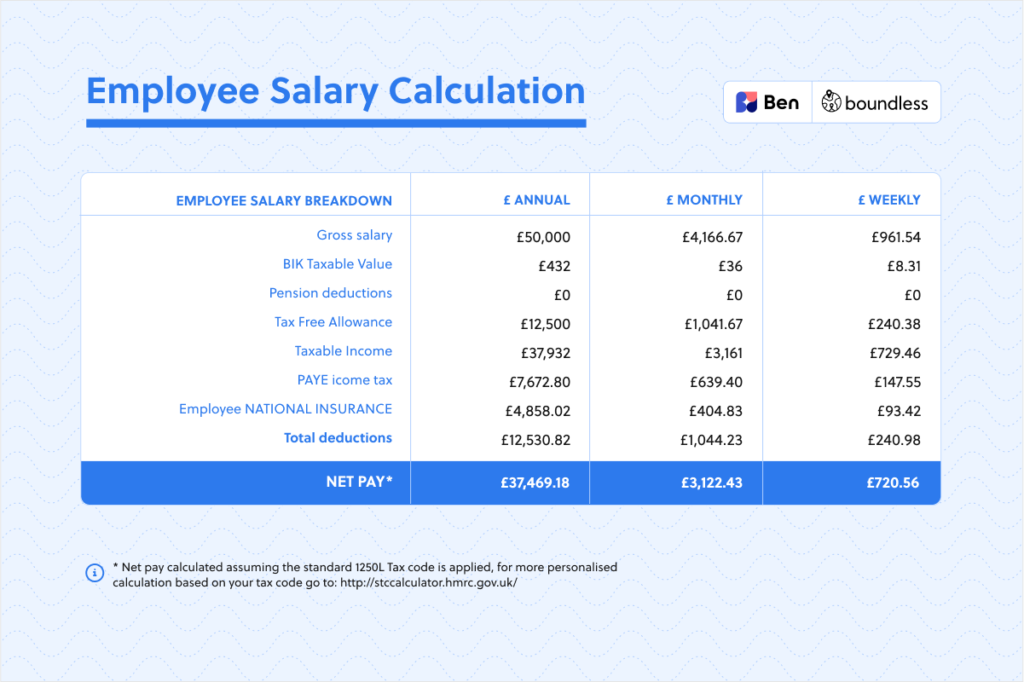
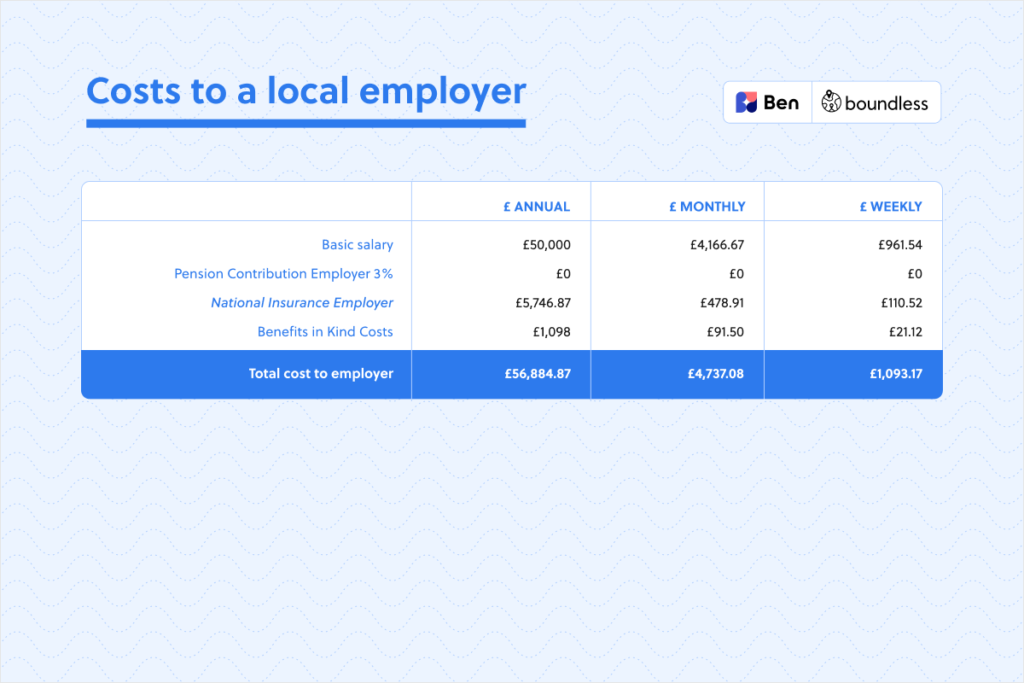
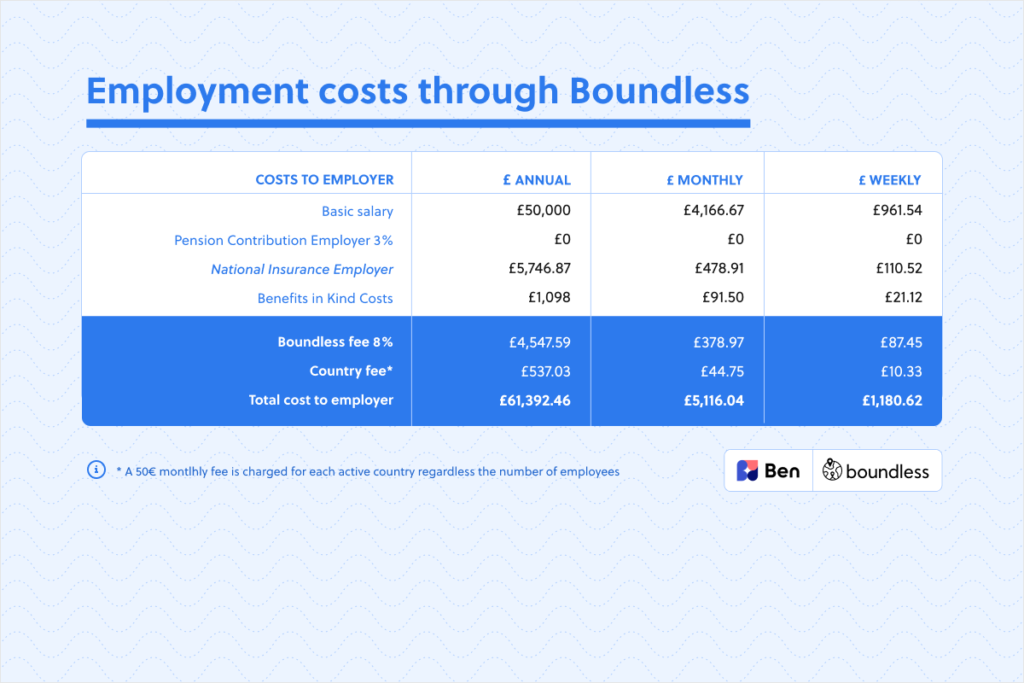
We hope this and the previous two articles have helped you to get the full lowdown on benefits in the UK, including how to create your own package. If you need any further help with a bespoke package, reach out to Ben. If you need to understand more of the UK's employment legislation, have a look at our comprehensive UK Country Guide. If you are not HQed in the UK but have workers there and want to offer them a fully compliant and fair employment experience, Boundless can help.

When an employer decides to legally and compliantly employ an internationally remote employee, one of the first things they need to come to terms with are the employee rights of their country. Here is a guide to employee rights in Ireland.
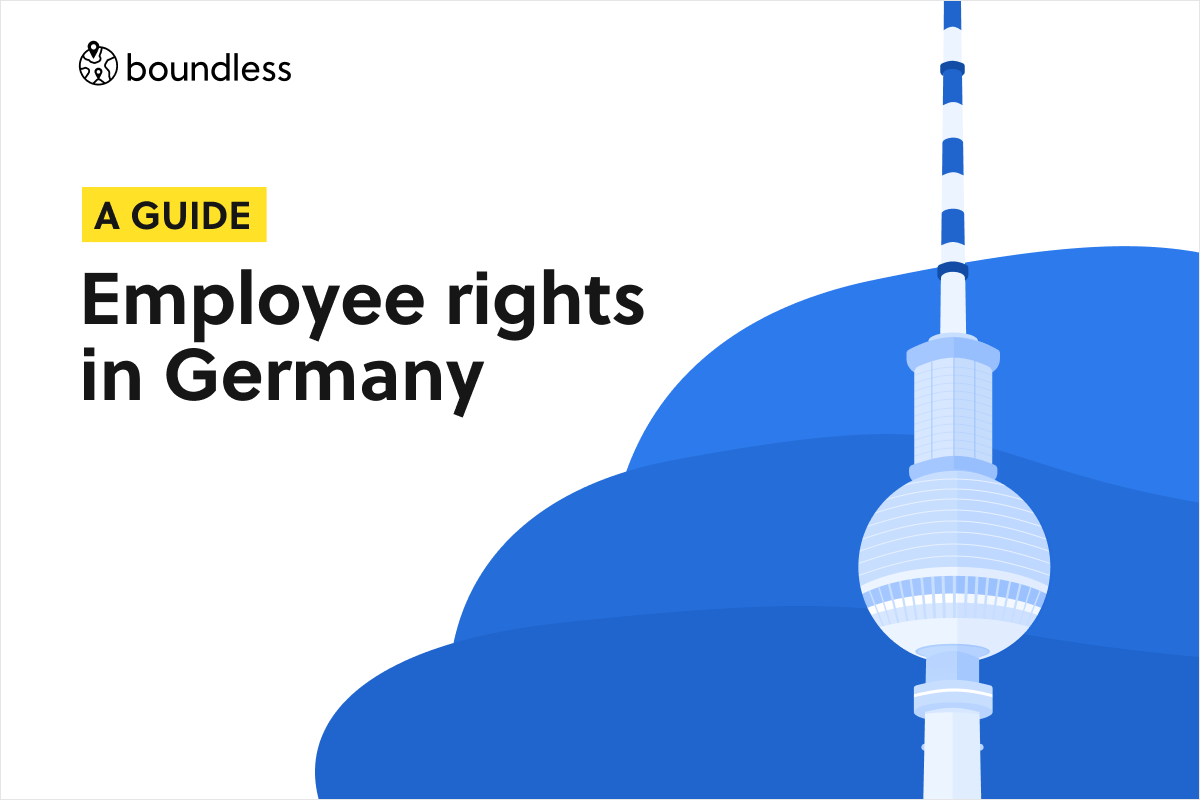
Compliant employment comes with a lot of obligations you have to be on top of. When you are doing that in a foreign country, everything will be brand new and you will have a lot of learning to do. Here is a guide to employee rights in Germany to help you understand what you need to comply with.

Savvy businesses know that to attract and keep hold of employees they need to set themselves apart from the competition – easier said than done in today’s increasingly remote-first working world, where people can work for pretty much anyone, anywhere.
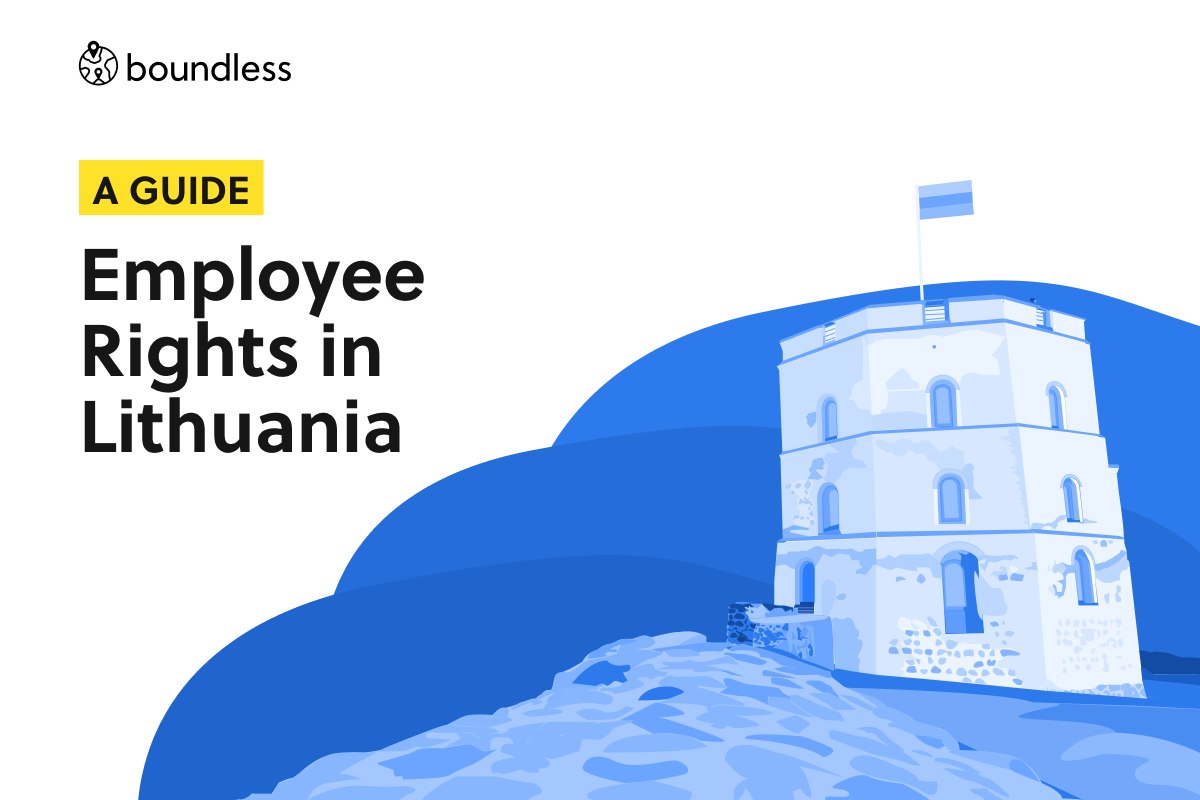
Considering employing someone in Lithuania? Check out our guide to employee rights to understand what you need to comply with as an employer.

An extensive guide on how benefits in kind tax works around the world, when employees are exempted from it, how companies can offset it, and how to file benefit in kind taxes accurately for your employees.

A benefit in kind is any non-cash benefit of monetary value that an employer provides to employees. Unlike statutory benefits, which are mandated by the government, benefits in kind are something that a company offers at its own will.